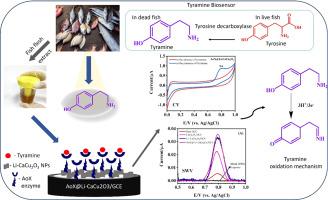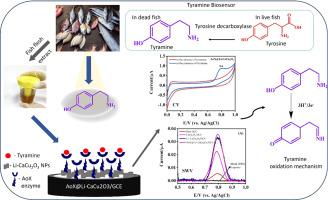Amine oxidase@Li-CaCu2O3 based electrochemical biosensor for the detection of tyramine in marine fishes and crab
IF 5.6
3区 材料科学
Q1 ELECTROCHEMISTRY
引用次数: 0
Abstract
Quality analyses of seafood ensure consumer safety, maintain public health, and support the sustainability of the fishing industry. As seafood is a perishable commodity, it is particularly susceptible to contamination by pathogens, biotoxins, and spoilage. Elevated levels of Tyramine (TA) in seafood indicate its quality deterioration through spoilage due to ageing, improper storage or poor handling. Here, we report a novel enzymatic biosensor integrating Amine oxidase (AoX) enzyme with Li-doped CaCu2O3 nanoflakes for the quantification of TA in various marine fish species. The AoX enzyme has been covalently immobilized onto the Li-CaCu2O3/glassy carbon electrode (GCE) via the cross-linker glutaraldehyde. The AoX@Li-CaCu2O3/GCE exhibited excellent electrocatalytic activity and high sensitivity towards the TA detection. High specificity of the AoX enzyme, flake-like morphology, mixed-valence copper centres (Cu2+/Cu1+) and improved electroactive surface area of Li-CaCu2O3 provide abundant active sites, resulting in an improved redox behaviour with higher current response. Further, the sensor efficiently detected TA over a wide concentration range of 0.15 to 250 μM, with the lowest detection limit and limit of quantification of 0.11 μM and 0.37 μM respectively. In addition, the real-time applicability of the AoX@Li-CaCu2O3/GCE has been validated by quantifying TA in marine fishes such as trevally, silver, lady, mullet, anchovy, pipe, cobia fish and sea crab. The obtained results have been cross-validated by high pressure liquid chromatographic analysis. Further, the sensor showed acceptable relative standard deviation (1.02-1.96%) and recovery values (98.1 – 101.5%). In conclusion, the fabricated AoX@Li-CaCu2O3/GCE could be useful for rapid and precise sea food analyses.


基于胺Oxidase@Li-CaCu2O3的电化学生物传感器检测海洋鱼蟹中酪胺
海产品的质量分析确保消费者安全,维护公众健康,并支持渔业的可持续性。由于海鲜是一种易腐烂的商品,它特别容易受到病原体、生物毒素和腐败的污染。海产品中酪胺含量升高,表示由于陈年、储存不当或处理不当而导致食物变质。在这里,我们报道了一种将胺氧化酶(AoX)酶与li掺杂的CaCu2O3纳米片集成在一起的新型酶生物传感器,用于定量各种海洋鱼类中的TA。通过交联剂戊二醛将AoX酶共价固定在Li-CaCu2O3/玻碳电极(GCE)上。AoX@Li-CaCu2O3/GCE表现出优异的电催化活性和对TA检测的高灵敏度。AoX酶的高特异性、片状形态、混合价铜中心(Cu2+/Cu1+)和Li-CaCu2O3电活性表面积的改善提供了丰富的活性位点,从而改善了氧化还原行为和更高的电流响应。此外,该传感器在0.15 ~ 250 μM的浓度范围内有效检测TA,最低检测限和定量限分别为0.11 μM和0.37 μM。此外,AoX@Li-CaCu2O3/GCE的实时适用性已通过对鱼、银、鱼、鲻鱼、凤尾鱼、管鱼、cobia鱼和海蟹等海洋鱼类的TA进行量化验证。所得结果经高压液相色谱分析交叉验证。传感器具有可接受的相对标准偏差(1.02 ~ 1.96%)和回收率(98.1 ~ 101.5%)。由此可见,制备的AoX@Li-CaCu2O3/GCE可用于快速、精确的海产品分析。
本文章由计算机程序翻译,如有差异,请以英文原文为准。
求助全文
约1分钟内获得全文
求助全文
来源期刊

Electrochimica Acta
工程技术-电化学
CiteScore
11.30
自引率
6.10%
发文量
1634
审稿时长
41 days
期刊介绍:
Electrochimica Acta is an international journal. It is intended for the publication of both original work and reviews in the field of electrochemistry. Electrochemistry should be interpreted to mean any of the research fields covered by the Divisions of the International Society of Electrochemistry listed below, as well as emerging scientific domains covered by ISE New Topics Committee.
 求助内容:
求助内容: 应助结果提醒方式:
应助结果提醒方式:


